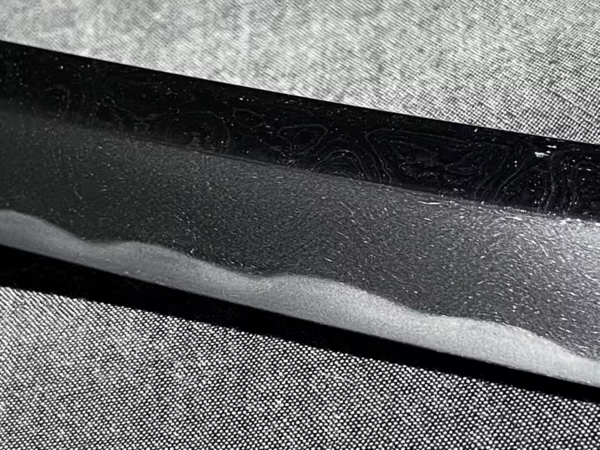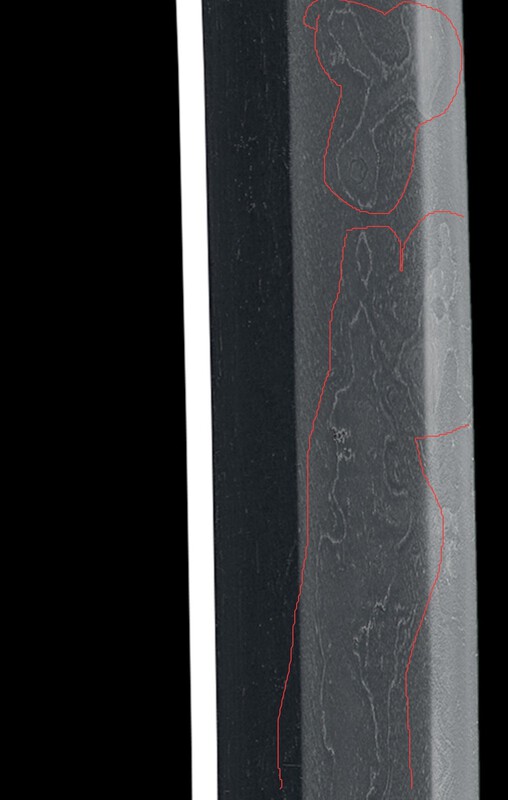-
Posts
52 -
Joined
-
Last visited
Content Type
Profiles
Forums
Events
Store
Downloads
Gallery
Everything posted by YourBabyBjornBorg
-
.thumb.png.54593db2789c8a1dcb235543b184ce39.png)
Can't read the number on the torokusho
YourBabyBjornBorg replied to Moritsuchi's topic in Translation Assistance
The Sori on this Torokusho is “なし/None”. -
.thumb.png.54593db2789c8a1dcb235543b184ce39.png)
Identify the markings on this katana
YourBabyBjornBorg replied to NomiHaku's topic in General Nihonto Related Discussion
Hi! This is 則光/Norimitsu. -
.thumb.png.54593db2789c8a1dcb235543b184ce39.png)
Found this in the wall
YourBabyBjornBorg replied to stuckineriver108's topic in Translation Assistance
This is 備前国長舩住祐定作/Bizen no Kuni Osafune-Ju Sukesada Saku. -
Hi! This looks like a 兼友/Kanetomo. Edited: A 友 with an extra dot on the upper-right is one of the older ways to write 友, first seen usage from at least the end of the Three Kingdoms time(220 AD~). All of these are from the Tang dynasty (618 - 907 AD), though. It seems that Koto period Kanetomo uses this version more often, with occasional regular 友. (Picture from "Encyclopedia of Mino-Tou")
-
.thumb.png.54593db2789c8a1dcb235543b184ce39.png)
Help with identifying the markings on this sword.
YourBabyBjornBorg replied to Dave69's topic in Nihonto
This is upside down. This reads "石鳥マキ(Ishitori/Sekicho Maki)". 石鳥 could be Ishitori or Sekicho. Edited: Woops! I forgot to mention that this is likely someone's name, not the signature of the swordsmith. "Maki" is usually feminine, but could work as a masculine name, too. -
Wow! That's a huge number of pre-Edo Gassan signatures! Yes, I understand there is huge variance in accepted Gassan signatures, so not finding anything like this in a very small sample pool of 10+ signatures is not the end. I think I even saw one where the character 月 looks like it's lying down on the ground, very weird indeed.
-
Thank you! Oh, I know this one by the NHTHK! "刀 銘 月山 (と銘がある・室町時代)/ Katana Mei Gassan (To Mei Ga Aru, Muromachi period)", for when it is Gimei, but it's correct about the attribution. Sadly, there is no photo that shows Sugata well, the first one is the best one we have here, and from the looks of it, it's not from late Nanboku-Cho, when one of the earliest signed Gassan, the only designated Important Art Object, is attributed to. it looks a little Koshi-Zori, and if this is indeed Muromachi, then there should be a little Saki-Zori, too. (Typical Muromachi Tachi Sugata, with both Koshi-Zori and Saki-Zori. I chuckled a little when I first saw one referred as such in a book.) Still, a possible or controversial Gimei is as bad as Mumei to me, and I would also hesitate to spend almost 5 grand just to find out what NHTHK would make of this.
-
Indeed. I would assume this sword failed its Shinsa at NHTHK, and that's why it's without paper and at this price. (I'm not sure if this sword is physically in PRC, though. Dealers here rarely photograph swords this well. These photos could be from a Japanese dealer.) And yes, the Hada on the Shinogi is almost as clear as below. Not impossible for a traditionally polished sword, but also a little suspicious.
-
Greetings, good people of Nihonto Messege Board! I always thought my very first topic would be in the Izakaya forum, where I finally introduce myself, a random person just all of a sudden showed up there and started typing random stuff, properly to everyone, and more importantly explain in what kind of stage of Japanese Swords learning I am, but I just can't resist sharing this peculiar sword I saw tonight with everyone, alongside a very little research of my own on signed Gassan. (Multiple sources in PRC posted this for sale at 4600 dollars americano without any certification, but I don't know if the sword itself is in PRC.) As we can all see, this is indeed a very beautiful Ayasugi-Hada sword. However, as is one of the conundra of Japanese Swords appraising, a precious Koto with very fine Hada is sometimes rather hard to tell from a Shinto or even Shinshinto, and I am truly stumped by this. There are so many schools that make Ayasugi-Hada swords throughout the history of Japanese swords, Gassan, Mokusa, Naminohira, Hoju and so on, even the later appointed Living National Treasure, Gassan Sadaichi, was once a known Gimei maker in the record of Fujishiro Yoshio Sensei. As for the signature, I compared this with more than ten different signed Gassan including a designated Important Art Object, but failed to find anything alike. However, it suddenly dawned on me that there might be something wrong with this Nakago. If this is indeed from the early Muromachi period, like the signature implied, then there should be more pitting corrosion and rusting in general on the outskirts of Nakago than the inside, a phenomenon that, if we pay enough attention, is then everywhere to be found on Japanese swords, even with Shinshinto or Gendaito from Showa. (I first learned this in Nakahara Nobuo Sensei's book. Yes, I am aware that many of his views are highly controversial, but he does have some valid points on spotting Gisaku.) This Nakago, however, is suspiciously evenly rusted, and almost without any pitting corrosion. If this Nakago is tempered with artificial rust, then the authenticity of its signature is in question, too. Because I have great concern about the whole Mumei Kiwame system, It has always been my dream to obtain an affordable, signed, and most importantly, stunning Koto before Muromachi, this sword looked like it at the beginning, but I am afraid I will have to dream on. What do you think of this sword? Is the Kitae-Hada Koto-like? Does the Nakago look at least 400 years ago? Do please share your precious opinion. Thank you! (Some would argue that Utsuri is a telltale sign of Koto, but I think someone capable of making this stunning sword would also be able to make Utsuri, just like people in Shinto, Shinshinto or even Gendaito period.)
-
First a little detour, because just 30 minutes ago I studied quite a number of authentic signed Ko-Gassan for an unpapered one, apparently there is even a signed Nagamitsu from Ko-Gassan school (and it's a Juyo, too). It was mentioned in "Swords' Talk with Kunzan/薫山刀話", then I saw its Oshigata in "Random Thoughts of Nihonto/日本刀随感" by Kataoka Sensei. Besides the one great swordsmith we all know and love that brought great fame and honour to it, Nagamitsu/長光 is just a very auspicious name for swordsmiths, meaning "to shine for a long time (長く光る)", so no wonder many smiths happen to choose it for their name, in different times and places. Edited: Now that I had a few minutes to look at the first sword on Aoi san, I would say that's a very typical Prison Nagamitsu, and almost every traits of it point to this same conclusion. It is unfortunate that I cannot develop my statement without detailing how the many less-than-ideal characteristics of this sword lead to this result and being rude to it. Although this reminds me of what Fukami san of Choshuya said, (paraphrasing) "make sure the signature is the last thing you look at when telling where, when, and by whom a sword is made.", suggesting we put Sugata, Ha, Ji and other attributes, i.e., what the sword really is, in front of the mere signature when appraising a sword. Anyway, just some random thought. Not nearly as good as Kataoka Sensei's though. Why, what a great book "Random Thoughts of Nihonto" is!
-
This is "Taira Nagamori/平長盛" from Taira Takada school.
-
.thumb.png.54593db2789c8a1dcb235543b184ce39.png)
Help with identification and thoughts
YourBabyBjornBorg replied to AntiqueBuyersofChicago's topic in Nihonto
Hi! This is a Gunto, and the signature says, "兼宗 Kanemune 昭和十八年九月 September, 1943". -
Oh my! Katanahanbai/Maruhide Touken san mesured shinogi to shinogi kasane (shinogi-kasane/鎬重ね) and marked them as simple kasane? That's scandalous! I wonder what other reputable Japanese dealers do this......
-
Thank you!!! Gosh darn it, I knew it! Because I think I remember hearing people say"Togiberi" in videos and in person, but when I want to confirm that, I couldn't for the life of me find any of those videos, while Google search only showed 研ぎ減らす/Togiherasu on Kotobank. Then I wanted to ask someone, but this is such a trivial question, so I was worried about bringing Meiwaku to the people I asked. This really helped my OCD! I can't thank you enough, Tsuji san! ♡♡
-
Hi! The first picture is where I think the Shingane is exposed. The second picture is where I think Tsukare-Utsuri(Utsuri of a tired blade) is showing. The other side shows a much better state of Kitae, with much less Oomoyo and Hada-Tachi places or Tsukare-Utsuri-like places, almost just regular Utsuri along the Shinogi, which is the reason I believe Togi-Heri caused what we see in both pictures, and it's not what this sword looked like originally. and I will have to reserve my opinions on Tsuruta san's for-sell sword descriptions, especially on Kitae or the state of Togi-Heri, for polite reasons.
-
.thumb.png.54593db2789c8a1dcb235543b184ce39.png)
Need help translating handwriting on sayagaki
YourBabyBjornBorg replied to TomHT's topic in Translation Assistance
Edited: This says "濃州関住人兼岩 Noushu Seki Junin Kaneiwa, 七字有銘而銘鑑ノ欠ケヲ補ウ新刀期ノ兼岩也 signed with a 7-Kanji signature, a Shinto period Kaneiwa that filled a missing place in Meikan, 反高キ形態而杢立ツ 板目ニ白気映立チ with Sugata that have high Sori, shows Mokume-Hada and Itame-Hada, and has Shirake-Utsuri, 刃文ハ尖刃主調ノ互ノ目調ノ乱ヲ焼クナド Hamon is a Gunome style Midare that is mainly Togariba, and etc., 関傳ヲ良ク継承シタル出来ヲ示ス所作也 overall a Shosa showing (the swordsmith is) well-inherited of the style of Seki-school, 刃長弍尺三寸一分半 length at 2 Syaku 3 Sun 1 Fun and half (70.14cm), dates (a little too blurry to read), 探山識(花押) Inspected by Tanzan, followed by his Kaou." Translation coming up after my dim sum! Delivery takes forever, so......↑ Also, some notes for a better understanding: "Shirage-Utsuri" is a kind of Utsuri that is known to show on Koto period Mino/Seki swords, ナド literally means etc., so it's not that I just skipped some part there, and I think that etc. means what all he said above (Sori, Hada, Shirake-Utsuri, Hamon, etc.) is the overall Shosa. "Shosa" can mean different things, and in this context it is interchangeable with Deki and other words, meaning......what this looks like overall? It's a very universal word. -
This says “脇差 銘 武蔵太郎安国 真十五枚甲伏作 長一尺七寸一分強”, translates to "Wakizashi Signed with ‘Musano Taro Yasukuni Made with authentic 15-layered Koubuse method’, with 51.8cm of length", but no dates, I'm afraid. Edited: (https://www.mandarinmansion.com/glossary/shin-jugomai-kobuse) I found a great webpage↑ that details what 真十五枚甲伏作 is with Markus Sesko San's great work! I also tried to do my own research, but 劔刀秘寳, 古伝鍛刀術, or 日本刀の科学的研究 are no easy read, especially at 2:30 AM here. So off to bed I go orz (There are two generations of Yasukuni, so if we can get a closer look at the signature, maybe we can tell which generation it is! Yasukuni I was 1651-1730, and Yasukuni II was ?-1742.)
-
Truly a beautiful Nobutaka II, congratulations on your purchase!
-
.thumb.png.54593db2789c8a1dcb235543b184ce39.png)
Mei attribution massive confusion. Koto or shinto???
YourBabyBjornBorg replied to TomHT's topic in Nihonto
Yes, Tom San, I, too, think around Keicho would be a safe assumption. Although, just a little further discussion, sugata-wise, it could break either way. This sword has a rather ideal sugata, almost Hizen-Shinto-like (they are noted for good Sugata in Edo period), but depending on who you ask, this could have a little Saki-Zori, a staple of late-Muromachi. Anyway, Sugata, and style in general, are intertwined between adjacent time periods. A Ouei-Bizen sword can look exactly like its Nanbokucho predecessors, and an Azuchi-Momoyama to early Edo sword can be almost indistinguishable from a late-Muromachi one, especially in Seki, where I always feel like a little stunned in time. However, I would think that Nakago alone is definitive enough for its Shinto status. Anyway, off to have my bowl of super spicy greasy stir-fried beef on rice! I'm so not a morning person, and I can barely think straight without my morning dosage of carbs. -
.thumb.png.54593db2789c8a1dcb235543b184ce39.png)
What is this knife?
YourBabyBjornBorg replied to Kotetsu1959's topic in General Nihonto Related Discussion
It says 以古来鍛法作之("Made with smithing technique from old times"). However, I think this is not a Kogatana meant to fit inside a Kodsuka, but rather a fancy Kiridashi-Kogatana, a kind of traditional Japanese tool knife, having almost nothing to do with Japanese Swords collections. An actual Kogatana meant to fit inside a Kodsuka, presumably made by the same team, with almost the same signature (a different Kanji for "Made" though), but also signed by the Swordsmith, fetched 17,000 Yen on an online auction, (https://www.funbid.com.hk/yahoojp/auctions/item.php?aID=k1109026141) so ideally, this Kiridashi-Kogatana should be around the same price. Hope this helps! Edits: Totally overlooked one important thing: this knife appears to have a Yakiba, and some light polishing. Got too carried away when searching for the other information. -
.thumb.png.54593db2789c8a1dcb235543b184ce39.png)
Mei attribution massive confusion. Koto or shinto???
YourBabyBjornBorg replied to TomHT's topic in Nihonto
First of all, yes. There are many records of Kotou signed "Noshu Seki Junin Kaneiwa". In fact, we can find the exact same 6 descriptions about Kotou period Kaneiwa at Nihonto Club (KAN1025-1030), in "Encyclopedia of Mino-tou” by Tokunou Kazuo Sensei (who also wrote “Encyclopedia of Swordsmiths”, although sadly I don't have). Kaneiwa is also mentioned in other books like “Corpus of Swordsmiths/刀工全集” by Dr. Shimizu Tooru, “Pandect of Swordsmiths/刀工総覧” by Kawakuchi Noboru Sensei and many more, all describing swordsmiths in Eisho (1504-1521) or Tensho (1573-1592), in the Kotou period. ......On the other hand, the only Oshigata of Kotou Kaneiwa is of a Tanto, with Higaki-Yasuri instead of Takanoha, a much thinner Tagane, and a different font. (It's like the Tanto on Asahi Touken, but the font is, again, different.) So, I took the liberty to glance at a webpage of Touken Tokugawa, where I think this sword was sold. (A random information, the same sword is also sold at Yahoo! auction for 333,000 Yens on the 25th of March this year.) It could just be the Sashikomi-Togi, but I am getting a little Azuchi-Momoyama to early Edo Minou Shinto impression. The Kitae is a little too tight and neat for Sue-Seki, although Sue-Seki Katanas do tend to have more refined Kitae than Tantos and Wakizashis from (my very limited) experience. So Kitae-wise, this could be a very well-made Sue-Seki, or a good Azuchi-Momoyama to early Edo Minou Shinto. Hamon is Nioi-Deki (some would say Ko-Niedeki) with Nioiguchi Shimari-gokoro, while being THE default description for Sue-Seki, could also apply to Minou Shinto from Azuchi-Momoyama to early Edo period. Nakago, both the Yasurime and font, like what Rivkin San shrewdly pointed out, looks Edo period. When searching for Kaneiwa, I did not find any source of the Shinto period Kaneiwa. ......Which I guess could be what they really meant by "not in the Meikan".














